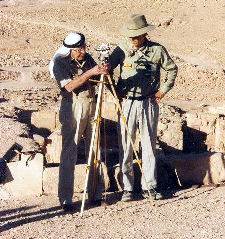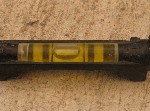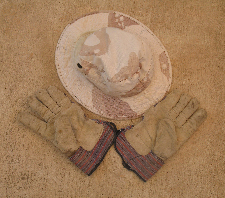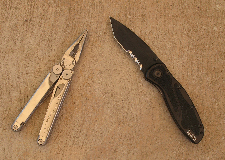
Dr. Philip Hammond and John Czarzasty at the Temple of the Winged Lion, Petra, Jordan, July 2001
It’s all about the data…
I was at Petra working for the late Dr. Philip Hammond in 2001 when he was asked by a visitor what the most valuable thing was that he had ever recovered from an archaeological site. Dr. Hammond, who had worked in Jordan for 50 years, most of that time right at Petra, instantly replied, “The data.” You are an archaeologist, not an antiquarian, so be prepared to carefully record your findings and amass that data. Have a clipboard, pencils, erasers, and pens. I specifically recommend multiple black Sharpies of every available tip size to use for the more permanent labeling that will be done.
Measuring Elevation…

Line Level
You Call That a Knife????
By this time, you will have noticed that it is very handy to have a cutting tool at hand, if for no other reason yet than to cut the string. A good knife is useful on the site, and a multipurpose tool such as those made by Leatherman or Gerber are constantly being used for a multitude of tasks including cutting. For example, the easiest way to remove rebar of any length is by using the pliers on a multipurpose tool. Have one in your kit (and always remember who came by to borrow it so you can find it when you need it).
Protective Gear

Protective Gear
Protect yourself with proper clothing and water…
Though not specifically archaeological gear, there are two things that I recommend that directly affect your well being on a dig. The first is your water supply. It doesn’t have to be Arizona in 112 degree F heat as it is today as I write this for water to be crucial. Bulk water will be provided on site at any dig with responsible adults running it, but top off your own water containers before you leave for the site or for your unit at the beginning of the work day, and then drink water early and often.
The second thing is your attire. This can be subject to variation due to the multitude of climates we work in, but make sure you have and use appropriate attire. Hats and gloves are of primary importance. Come prepared for changing conditions throughout the day. No site needs people freezing during the mornings and then keeling over from the heat in the afternoons.
And finally…
A multitude of other gear such as shovels, hand picks, large picks and screens are provided at most digs and schools. If you have any doubt about what you will have to provide for yourself, just ask. In most cases organizations will have available a published lists of required personal gear for prospective field crew members. And once you have worked on a few sites, you will add to your kit according to your tastes. With the gear listed above, you will be set to do the job in the field. Some digs or schools may require more or less, but I think that this is a good start.
To go back to page 1 of Archaeology Tools, click here…


